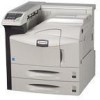Kyocera 9530DN Operation Guide - Page 18
Thick Paper, Colored Paper, Preprinted Paper, Recycled Paper, Handling Paper, ADVANCED OPERATION GUIDE
 |
View all Kyocera 9530DN manuals
Add to My Manuals
Save this manual to your list of manuals |
Page 18 highlights
Handling Paper Do not use envelopes that have an encapsulated liquid adhesive. Avoid long printing runs consisting of envelopes only. Extensive envelope printing can cause premature printer wear. To avoid jamming due to curled envelopes, do not leave more than approximately 10 printed envelopes stacked in the paper trays during multiple envelope printing. Thick Paper Fan the stack of paper and align the edges before loading them in the MP tray. Some types of paper have rough edges on the back (those are created when the paper is cut). In this case, put the paper on a flat place and rub the edges once or twice with, for example, a ruler to smooth them. Feeding rough edged paper may cause paper jams. NOTE: If the paper jams even after you smooth it out, load the paper in the MP Tray with the leading edge raised up a few millimeters. Colored Paper Colored paper should satisfy the same conditions as white bond paper, listed in Paper Specifications on page 1-3. In addition, the pigments used in the paper must be able to withstand the heat of fusing during the printing process (up to 200 °C or 392 °F). Preprinted Paper Preprinted paper should have a bond paper base. The preprinted ink must be able to withstand the heat of fusing during the printing process, and must not be affected by silicone oil. Do not use paper with any kind of surface treatment, such as the type of paper commonly used for calendars. Recycled Paper Select recycled paper that meets the same specifications as the white bond paper (refer to Paper Specifications on page 1-3) except whiteness. NOTE: Before purchasing recycled paper, test a sample on the printer and check that the print quality is satisfactory. 1-12 ADVANCED OPERATION GUIDE















